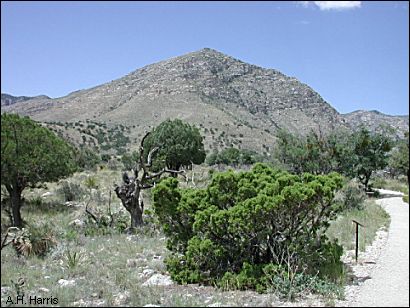
The juniper, often mistakenly called cedar by inhabitants, is a familiar tree of the mountain slopes throughout the Chihuahuan Desert region. Of course, it isn't really "the" juniper—rather, we are blessed with a number of different species, each with its own ecology and distribution.
Alligator Juniper tends to occupy the higher elevations, usually
between 4,500 and 8,000 feet. Why name a tree after a crocodilian? Those of you who
have seen this tree know the answer--the bark cracks into squares that nicely mimic the
hide of our American Alligator. At lower elevations, One-seed Juniper and, in the
northeast, Pinchot Juniper tend to take over. Grasslands degraded by overgrazing or
drought tend to be invaded by these plants from their more common habitat of shallower,
rocky soils. From the Chisos Mountains of Big Bend through the mountains of much of
northern Mexico, the Drooping Juniper lends a unique look to the landscape with its
drooping branchlets. All have in common the fragrance that Southwesterners never
forget, once encountered.
![]()
Contributor: Arthur H. Harris, Laboratory for Environmental Biology, Centennial Museum, University of Texas at El Paso.
Desert Diary is a joint production of the Centennial Museum and KTEP National Public Radio at the University of Texas at El Paso.

The shrub in the foreground and at the left and center represent two different species of junipers. Many of the trees climbing the lower slopes in the far background also are junipers. Guadalupe Mountains National Park. Photograph by A.H. Harris.